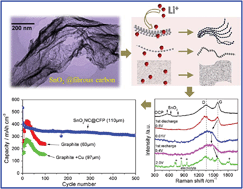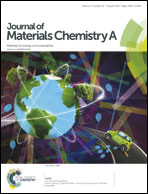Deformable fibrous carbon supported ultrafine nano-SnO2 as a high volumetric capacity and cyclic durable anode for Li storage†
Abstract
Multidimensional fibrous carbon scaffolds, derived from carbonized filter papers (CFPs), were used to support SnO2 nanocrystals (NCs, with a size of 4–5 nm) to form a free-standing SnO2NC@CFP hybrid anode for Li-ion batteries. The SnO2NC particles are well accreted on the surfaces of 1D carbon fibers and 2D ultrathin carbon sheets while maintaining 3D interconnected pores of the carbon matrices for fast ionic transport. The SnO2NC@CFP hybrid electrode exhibits long-term higher energy density than the commercial graphite anode, and excellent rate capability, mainly due to good dispersion of SnO2 in the multidimensional conductive carbon. In particular, the reversible deformation of the flexible fibrous carbon matrices, as inferred from in situ Raman spectroscopy and SEM image analysis, facilitates stress release from the active SnO2NCs during discharge–charge cycling while maintaining the structural integrity of the self-supported SnO2NC@CFP anode. These demonstrate that the rational combination of the multidimensional architecture of deformable carbon with nanoscale active materials is ideally suited for high-performance Li-ion batteries.


 Please wait while we load your content...
Please wait while we load your content...